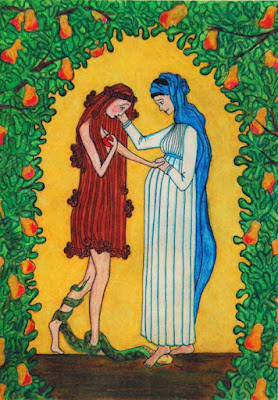THE MASS OF EMMAUS, THE PLACE TO RECOGNIZE THE RISEN LORD.
April 26 2020: Third Sunday of Easter – A.
A Cuban proverb says, “Brief encounters can result in long
relationships.” And a Ghanaian proverb adds, “Dogs do not actually prefer bones
to meat, it is just that no one ever gives them meat.”
Easter season is the time where each Christian is called to
rediscover and reevaluate his sacramental life. That goes from the Baptism, the
sacrament of Reconciliation, the Eucharist, and the Confirmation, and even it
can touch also the sacraments of service, Matrimony, and Holy Order. For,
Easter is a sacramental season, Christ being the Sacrament of all sacraments,
the Mystery of all mysteries, the center and visible sign of all things.
Rightly, many Parishes and communities choose the Easter season to celebrate
most of the sacraments of Christian Initiation. I remember that I received
those sacraments on the Easter season.
In this sacramentality of Easter, the Eucharist holds a very
singular and significant position. For, it stands as “the source and the summit
of the whole Christian life” (Lumen Gentium 11). In that sense, without
exaggerating, one could reach the affirmation that Easter is a Eucharistic
season; not only because this sacrament was instituted during the Paschal
Triduum, but mostly because it stands as the greatest moment of encounter and
recognition of the Risen Lord. The Eucharist is also the sacrament of the
continual presence of Jesus amid his disciples. Through it, we feel a direct
contact and the touch of our Lord.
We are today the third Sunday of Easter. The word of God has
a very sacramental coloration, with the Eucharist at its Center. We are given
to see where we can truly meet and recognize the Risen Christ: “in the breaking
of bread” and by hearing His word.
Peter, in the first reading, sets the first condition, the
first place where to encounter the Lord. Addressing the people, he tells them
that the Scriptures and all the prophecies, from Moses to David, speak of
Jesus, and more, that David openly prophesized about the Lord’s Resurrection.
Thus, for the people of God to understand all the mysteries about Jesus, they
should have recourse to the Scriptures.
The same Peter, in his pastoral letter, reveals to the
Christian Community that the blood of Jesus shed on the Cross was the ransom of
their sins. Here, Peter stretches on one very relevant truth. Our salvation is
not acquired by silver and gold. No material goods and earthly wealth can save
man. It is only the blood of Jesus that saves. For, he is “a spotless
unblemished lamb.”
This lamb Peter speaks of is the same who is offered at the
Holy Altar during the Eucharistic celebration. Therefore, the Eucharist becomes
the par excellence moment of encounter and recognition of the Risen Lord.
The Gospel speaks of this recognition through the experience
of two disciples on their journey to Emmaus. The episode of Emmaus could be
well titled as the ‘Mass of Emmaus’ or the second Eucharistic celebration of
Jesus. We can find in it all the parts of our Masses. It starts with what could
be equal to the Liturgy of the Word. The Risen Lord comes to meet the two men
and discusses with them. That discussion is based on the Word of God. Luke
tells us that, “beginning with Moses and all the prophets, he interpreted to
them what referred to him in all the Scriptures.” That is actually what happens
with us, every time that we come at Mass. We come with our questions, lack of
comprehension of the events of our lives, our doubts, and our despairs. Then,
the Lord meets us with his word and explain all things to us. But because we
are slow to understand and to believe, we hardly can recognize his presence.
We, therefore, the need for another instance, the second part. Here it is
mentioned as ‘the breaking of bread’, known as the Liturgy of the Eucharist. We
read with St. Luke that the disciples invite their mysterious companion to stay
with them. Once in the house, they got to recognize him only in the breaking of
bread.
We talk here of the “Mass of Emmaus” because, the words and
this scene are perfectly similar to what the Lord did the evening before his
passion: “he took bread, said the blessing, broke it, and gave it to them.” It
is only then, the eyes of the two disciples were open to recognizing him. The
Eucharist in that sense passes to be the greatest moment where we can recognize
the Lord who comes to our encounter and journey with us.
Then the last part is about what the two disciples did once
their eyes were opened to recognize the Lord. This corresponds to the last part
of our Eucharistic celebrations, the dismissal. They went back to Jerusalem to
share the good news of the Resurrection to the other disciples. The Holy Mass
never ends without dismissal. But then, that dismissal becomes a sending off in
mission. Our mass, the mass of our life starts once the priest tells us, “Ite
Missa est”, Go the mass is ended. We are at that moment sent to bring Christ,
the one we have received to the people we will encounter.
Emmaus is a sacramental journey. The two disciples, like you
and me, journey in hopelessness with our questions and lack of faith. Then once
the Lord encounters us and makes himself known to us, we become messengers to
bring him to others. Let us not fail in our mission of giving Christ, the Risen
Lord to all in need of answer and hope.





Comments
Post a Comment